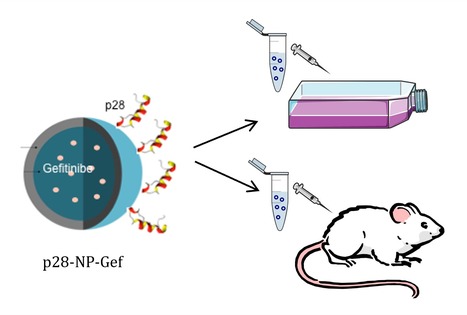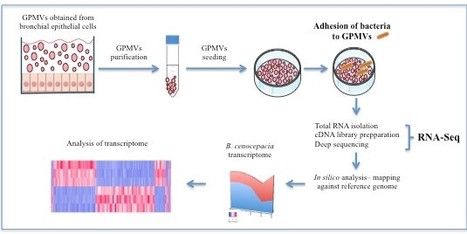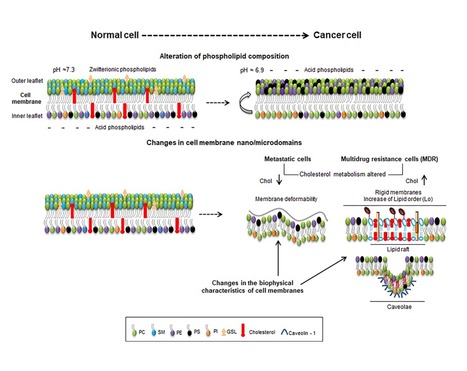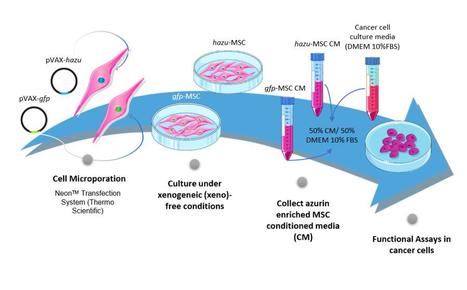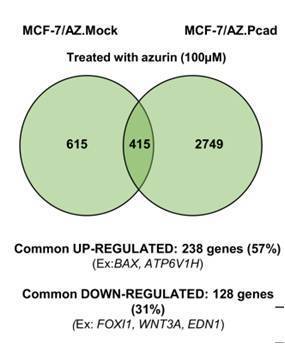 Your new post is loading...
 Your new post is loading...

|
Scooped by
iBB
November 26, 2021 11:26 AM
|
Quantitative FRET Microscopy Reveals a Crucial Role of Cytoskeleton in Promoting PI(4,5)P2 Confinement
Phosphatidylinositol 4,5-bisphosphate (PI(4,5)P2) is crucial to many cellular processes in eukaryotes, including membrane trafficking, signal transduction, ion channel function and cytoskeleton dynamics. This function multiplicity is partially achieved through a dynamic spatiotemporal organization of PI(4,5)P2 within the membrane. In a recent paper published in IJMS, an IBB team (Maria J. Sarmento, Luís Borges-Araújo, Sandra N.Pinto, Nuno Bernardes, Joana Ricardo, Ana Coutinho, Manuel Prieto and Fábio Fernandes) was able to quantify PI(4,5)P2 confinement in living cells making use of FRET imaging measurements. PI(4,5)P2 was found to be significantly compartmentalized at the plasma membrane of HeLa cells. These PI(4,5)P2 enriched domains were shown to not depend on cholesterol content, ruling out an association with lipid rafts. On the other hand, upon inhibition of actin polymerization, compartmentalization of PI(4,5)P2 was almost entirely eliminated, confirming that the cytoskeleton network is the critical component responsible for the formation of nanoscale PI(4,5)P2 domains.

|
Scooped by
iBB
September 3, 2021 10:37 AM
|
Gefitinib-Loaded p28-PLGA Nanoparticles Reduce Tumor Burden and Metastases in Lung Cancer
p28 is a 28 amino acids peptide derived from the bacterial protein azurin. It possesses cell-penetrating capabilities showing preferential enter in cancer cells. Moreover it has been subject in US to two phase I clinical trials as a anticancer agent. In a recent paper published in Journal of Controlled Release, a iBB team (Garizo AR, Dias TP, Fernandes F, Bernardes N, Fialho AM) together with a i3S/UP team (Castro F, Martins C, Almeida A, Barrias CC, Sarmento B) were able for the first time to fabricate p28-functionalized PLGA nanoparticles (NPs) loaded with the EGFR tyrosine kinase inhibitor gefitinib. The results obtained indicate that these NPs interact preferentially with lung cancer cells due to their decoration with p28 peptide. In vitro cytotoxicity assays demonstrate biological activity of the NPs against lung cancer cancer cells. Finally, in vivo studies demonstrated a great potential of the p28-NPs in enhancing the therapeutic effects of gefitinib.

|
Scooped by
iBB
March 14, 2021 8:09 AM
|
Burkholderia cenocepacia Transcriptome During the Early Contacts with Giant Plasma Membrane Vesicles
Burkholderia cenocepacia is a human contact-dependent pathogenic bacterium known for its capacity of causing severe opportunistic respiratory infections. B. cenocepacia uses a complex machinery for primary adherence with host cells. In a recent paper published in Scientific Reports, a BSRG-iBB team (Andreia Pimenta, Nuno Bernardes, Dalila Mil-Homens and Arsénio M Fialho) together with Marta M Alves from CQE, IST, have developed a RNASeq-based approach that led to identify adhesion candidate genes that were not previously reported in the context of a B. cenocepacia infection. This study presents a innovative technique in which their use Giant Plasma Membrane Vesicles (GPMVs) from a bronchial epithelial cell line as a cell-like alternative to investigate the steps involved in the adhesion process of B. cenocepacia.

|
Scooped by
iBB
December 13, 2018 10:32 AM
|
Perturbing the Dynamics and Organization of Cell Membrane Components: A New Paradigm for Cancer-Targeted Therapies
https://www.scoop.it/t/ibb/?&tag=Ars%C3%A9nio+FialhoUnlike the current paradigm of “one drug one target”, nowadays multiple-target approaches taking place at the cancer cell membrane are gaining much more relevance. The rational is based on the use of a new class of molecules that can exert significant changes in the dynamics and organization of cell membranes thereby affecting growth factor signaling, invasiveness and drug resistance. In a review published in a Special Issue “Receptor-Targeted Cancer Therapy” of the International Journal of Molecular Sciences, BSRG-iBB team members Nuno Bernardes and Arsenio M Fialho present and discuss novel approaches for cancer therapy, including the anticancer bacterial protein azurin.
|

|
Scooped by
iBB
October 20, 2021 6:08 AM
|
The Azurin-Derived Peptide CT-p19LC Exhibits Membrane-Active Properties and Induces Cancer Cell Death
The bacterial protein azurin shows an unexpected therapeutic effect against various types of cancer. This property seems to result from its unique structural and surface features. A 28-residue peptide (named p28) derived from the middle part of azurin has been subjected to various studies and reached two clinical trials phase I in US. In a recent paper published in Biomedicines, a iBB team (Ana Rita Garizo, Lígia Coelho, Sandra Pinto, Tiago Dias, Fábio Fernandes, Nuno Bernardes and Arsénio M Fialho) were able to identified another anticancer bioactive peptide (CT-p19LC) derived from the C-terminal of azurin. CT-p19LC proved to interact preferentially with cancer cells, causing a significative inhibition of cell proliferation in a dose dependent manner. Moreover, it is proposed that the mode of action of CT-p19LC involves perturbation or disruption of cancer cell membranes. Overall this study highlights the relevance of azurin as a source of bioactive peptides with potential application in cancer therapies.

|
Scooped by
iBB
April 12, 2021 9:58 AM
|
Burkholderia cenocepacia BCAM2418-induced Antibody Inhibits Bacterial Adhesion
B. cenocepacia is a contact-dependent bacterium known for its capacity of causing respiratory infections. Among a panel of adhesins used by B. cenocepacia to contact with host cells, trimeric autotransporter adhesins (TAAs) are of particular interest. In a recent paper published in Cellular Microbiology, a BSRG-iBB team (Andreia Pimenta, Nuno Bernardes, Dalila Mil-Homens and Arsénio M Fialho) together with Michelle Kilcoyne and Lokesh Joshi from the National University of Ireland Galway, Galway, Ireland, were able to uncover the roles of the TAA BCAM2418, as an adhesin and the type of host glycans that serve as recognition targets. This work reveals the importance of BCAM2418 as a mediator of early host-bacteria crosstalk.

|
Scooped by
iBB
July 3, 2020 6:43 AM
|
Conditioned Medium from Azurin-expressing MSC Demonstrates Anti-tumor Activity
Cell-based therapies can enhance the specificity of anti-cancer therapeutic agents. In this context, human mesenchymal stromal cells (MSC) hold a promising future as cell delivery systems for anti-cancer proteins due to their innate tropism for tumors. iBB researchers Marília Silva, Gabriel Monteiro, Arsénio Fialho, Nuno Bernardes and Cláudia Lobato da Silva, engineered human MSC through non-viral methods to secrete a human codon-optimized version of azurin (hazu), a bacterial protein with demonstrated anti-cancer activity towards different cancer models in vitro and in vivo. Upon treatment with conditioned media (CM) from these engineered cells, a decrease in cancer cell proliferation, migration and invasion was seen, and an increase in cell death was observed for breast and lung cancer cell models. The results achieved by SCERG- and BSRG-iBB researchers were published in Frontiers in Cell and Developmental Biology, Stem Cell Research section.

|
Scooped by
iBB
July 29, 2014 5:36 AM
|
BSRG researchers have unveiled new targets for the anti-cancer protein azurin using a breast cancer model. In a paper published jointly with colleagues from IPATIMUP in The International Journal of Biochemistry and Cell Biology, the team led by Arsénio Fialho describes the use of DNA microarrays to understand the effects of azurin in invasive breast cancer cells overexpressing P-cadherin. The gene transcription data gathered shows that apoptosis is induced and endocytosis is up-regulated to mediate the controlled process of azurin entry in cells. A number of genes coding for membrane receptors frequently overexpressed in breast cancer are down-regulated, suggesting that these new targets could be exploited in the future. Click on title to learn more.
|




 Your new post is loading...
Your new post is loading...


